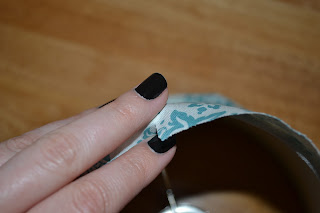When was the last time you bought a lamp? I can honestly say that aside from a miniature rooster lamp I got from a junk store a few months ago, I have not actually purchased a lamp for myself. Ever. We have a few that were wedding presents. I went to TJ Maxx to get a few for our bedroom and dern-- those suckers are expensive!
Over the weekend, we got new carpet and rearranged some furniture. I decided to get new lamps for our night tables, but I couldn't find any that I loved right off the bat. I knew I wanted something small, something with a white base, and something with teal in the shade. So... I decided to jazz up cheapy Walmart lamps.
Seriously, the bases were $4.98 each and the shades were $4.98 each. So, that's $20 and change for 2 lamps, plus the fabric ($2.10) and spraypaint ($4.99) I used. So all in all, less than $30 for two lamps that look like they're from a specialty shop. Keep reading to see how I did this (it's easy!).
You'll need:
A working lamp base
A plain white shade without pleats
A lightbulb
White spraypaint that is safe for the substance of your lamp base
Fabric
1. You'll need to clean and spraypaint your base if you're looking to change it. Follow the directions on the spraypaint-- some take longer to dry than others. I had to start painting mine a day before I made the shades. This lamp base was a tarnished black finish originally.
2. Make your shade. Be sure to press your fabric before measuring or cutting to avoid wrinkly mistakes. Many new lampshades come shrinkwrapped. An easy trick is to carefully cut off the plastic in one piece, lay it on your fabric, and trace the outline of the plastic + about 1/2 gap on every side. You'll end up with something like this:
This is also a good way to be sure your pattern will be straight.
3. Grab an extra set of hands and line up your shade with your fabric:
4: If desired, press or hotglue a hem on one of the overlapping back seam pieces:
5. Start gluing and pressing the fabric into place. Be diligent to avoid ripples and skews:
Also, make little slits on the fabric near the "spoke" part of the shade if needed.
Assemble your lamp, and here is your finished product:
Good luck!




















